
Setting up an eCommerce store these days is about as easy as tying a shoelace.
Having a profitable eCommerce store, however, is a whole other basket.
Great business owners know data. But smart business owners know how to take that data and make business decisions based on it.
Running an eCommerce store is different than running a company blog or website. While generating traffic and leads is important, there are also other metrics you should care about when it comes to running an eCommerce store.
Whether this is your first store or your second or third, tracking these key eCommerce Store metrics will help you to make better-informed decisions and ultimately make your business profitable.
Customer Lifetime Value (CLV)

Customer lifetime value is the prediction of the net profit attributed to the entire future relationship with a customer. To put it simply, it is all of the money you will get from a customer for the life of the relationship they have with you. Once you determine the clv, you can get a really good idea of how to invest your resources and what customers are most valuable for your business.
Gross margin

According to Investopedia, the gross margin is defined by the store’s total sales revenue minus its costs of goods sold, divided by total sales revenue, and expressed by a percentage. You should continuously monitor this number to make sure that your store is profitable. You can measure success by ensuring that your gross margin is a high number. The higher the percentage of your gross margin, the more the company retains on each dollar of sales.
Conversion Rate

This is probably the most important eCommerce store metric you should be looking at.
Conversion Rate is defined by how many visitors convert into customers. A common problem for eCommerce stores is that they get tons of traffic, but no actual sales come from the traffic. What’s more concerning is that the eCommerce industry as a whole only has about a 2.5% conversion rate.
While the reasons for this vary, a low conversion rate can be attributed to:
- Not showing social proof
- High prices for generic looking products
- Not getting enough qualified leads
- Not enough payment options
Because your conversion rate shows the success of how you turn visitors into customers, you want to make sure that you take the time to analyze the shopping experience you provide in your store.
Subscriber Growth Rate

The subscriber growth rate is a ratio that tells you how many new subscribers you are attracting.
Your store likely has multiple sources of subscribers.
Some examples are:
- Social Media Followers
- Newsletter Subscribers
- Monthly and Annual Product or Service Subscriptions
- Email List Subscribers
It’s very important to nurture these relationships by pushing out new content on a regular basis. Subscriber growth rate is a relevant number for your eCommerce store because it helps you to understand if your brand is hitting home and resonating with your audience.
For example, if you are selling clothes, a smart move would be to push out a variety of fashion-trend alerts to your customers as seasons and styles change.
Value Per Visit

An interesting data point that helps you quantify the value of each and every visitor to your website is the value per visit metric. This is the amount of money that is generated each time you have someone visit your site. You can calculate the value per visit by dividing the revenue of your site by the number of visitors over a given period of time. I’ve seen this data point used for advertising and in calculating the return on your marketing investment.
Average Order Value

Average order value takes a look at all the orders placed in a given time period and averages them out to give you an average order size. Some typical ways to increase your AOV might include:
- Bundle products together
- Selling add-ons or services
- Loyalty programs
- Mix & Match offers
Cart Abandonment Rate

Cart abandonment rate is the ratio of the number of abandoned shopping carts to the number of initiated transactions to the number of completed transactions. Did you know that most stores have a cart abandonment rate somewhere in upwards of 70%? That’s a horrifying statistic.
There are many reasons for this high number. Think about your own shopping experience. How many times have you pulled out your phone to look for a product and then get pulled away only to not have completed the shopping cart process?
What’s more interesting is that the top reason for cart abandonment is unexpected high costs during checkout. Research shows that 28% of shoppers abandon carts when presented with unexpected high shipping costs. And that makes sense.
When you start looking at a product you are presented with a price, say $19.99. You start thinking that it’s a decent price for that product and so you begin to check out. However, you will start to hesitate the minute you are asked to input your mailing address and find out that shipping isn’t included in the price. If your purchase is going to cost you another $5.50 to ship the product, you begin to question and second-guess how much you really want to buy the product.
The good news is that most of the customers surveyed also said they’d be willing to complete the purchase if these products were offered at a lower price.
“54% of shoppers will purchase products left in the shopping carts if those products are offered at a lower price.” – VWO
*Thankfully, our partners, Jilt, offer a solution for WooCommerce stores.
Inventory Levels
If you sell physical products and keep them on hand, you definitely want to keep track of your inventory levels. WooCommerce does this for you (assuming you put in inventory quantities in for your products) and will even send you notices of when your inventory starts to get below a certain threshold.
Average Order Size

If you divide the revenue by the number of transactions for a given period, you’ll end up with an average order size. This will help you understand how much a customer delivers to your bottom line. A good way to increase your average order size is to offer free shipping. You can have this kick in at a specific dollar amount or be applied for volume discounts.
New Orders vs Returning Customer Orders
You might have heard the saying, “Repeat customers are often the best customers.” In a retail brick and mortar store that’s absolutely true! My dad has been running a bicycle store for over 45 years. You know what? I still see people coming in to buy parts, even bicycles for their grand-kids, that I waited on when I was 15. They are repeat customers.
And the same goes for the eCommerce space as well. But when you reach a certain store size, it’s often hard to remember “Don” every time he buys from you. So eCommerce platforms offer a way to link customers to their orders, giving you a way to find these returning customers.
There are many different ways you can capture this metric. I personally think that grouping your first-time orders and returning orders makes the most sense. You can then take your total returning orders and divide that by your total orders (for a given time period of course) and get a percentage of returning orders. The same would hold true for new orders.
Product Relationship
How do you know what products are doing well and what products aren’t? Aside from looking at orders, you should consider looking at your page views on specific product pages. The correlation can be enlightening.
Say you have a product that has 10,000 page views and has 100 orders for the month. With this data, you can begin to take a deeper dive into why there is a lot of interest in the product, but not a lot of sales.
Customer Acquisition Cost (CAC)

This is a critical metric for both marketing and business folks. It helps to inform your bottom line and measure the effectiveness of any marketing efforts.
In a startup, you need a monthly view of this as a matter of survival because you have limited dollars to spend.
There are two ways you can measure CAC:
- Assisted conversions based on a chain of multiple visits to your site that eventually lead to a sale
- Direct sales conversions from a channel (based on the last click interaction)
You can use this information to make hard and fast decisions on when to stop or optimize your marketing campaigns.
Wrapping Up
Keeping track of your eCommerce business is important. Ensure that you have metrics in place that will help you set goals for the success of your business. Knowing these metrics is important, but is just half of the battle and you will have to put in a lot of work to improve the metrics. They will ultimately help you to make better, more informed decisions on how you market, sell and support your business.
A great way to decrease your cart abandonment rate and capture lost revenue, is to get started with our Managed WooCommerce Hosting Solution. All of our packages include Jilt, the leader in abandoned cart technology email automation for WooCommerce.
[ad_2]
Source link






